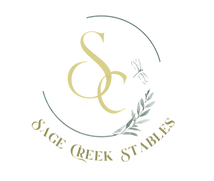Understanding Equine Biomechanics for Better Performance
- Sage Creek Stables

- Jul 24
- 2 min read

Elite riders don’t just train—they study. One of the most powerful ways to elevate your training is by understanding how your horse’s body works. That’s where biomechanics comes in.
At Sage Creek Stables, we integrate equine biomechanics into everything we do—because riding isn’t just about cues and correction. It’s about alignment, efficiency, and supporting your horse’s natural movement to unlock their best performance.
What Is Equine Biomechanics?
Biomechanics is the study of movement—how bones, muscles, tendons, and joints work together. In riding, this means understanding how your horse moves, carries weight, and generates power.
Informed riders make biomechanically conscious choices, helping their horses move:
More efficiently
More comfortably
With less risk of injury
With better balance, rhythm, and athleticism
Why It Matters in the Show Ring
Hunter/jumper horses are athletes. And like all athletes, their performance depends on correct form.
👉 A horse that’s hollow in the back or on the forehand can’t jump cleanly. 👉 A tight poll or weak hind end can lead to resistance, flat bascules, or refusals. 👉 Poor posture (in horse or rider) disrupts balance and damages trust.
Biomechanically informed training helps:
Build the right muscles gradually
Support soundness through correct work
Create better jumps through better preparation
Reduce wear-and-tear through balanced conditioning
How We Apply Biomechanics at Sage Creek
Every training session is shaped by observation and intention. We ask:
Where is the horse carrying tension?
Is there symmetry in movement?
Are they lifting through the back and stepping under from behind?
Are our aids helping or hindering movement?
Using these insights, we adjust:
Warm-up routines based on body language
Transitions and flatwork patterns to strengthen key areas
Pole work, cavalletti, and low-impact jumping to build coordination
Rider position to align with the horse’s center of gravity
Your Position Matters Too
Biomechanics isn’t just about the horse—it’s about the partnership. Your balance, timing, and seat can either enhance your horse’s movement or disrupt it.
We work with riders to refine:
Core engagement for quieter aids
Hip and shoulder alignment to reduce asymmetry
Hands and rein elasticity for better communication
Jump position that supports—not interferes with—the horse’s arc
Tips to Improve Biomechanics in Your Training
Video your rides. Watching movement in slow motion is eye-opening.
Work with poles. They encourage engagement and show asymmetries.
Ride in both directions evenly. Strength comes through balance.
Ask questions. Why is your horse resistant? Tension is information.
Include cross-training. Hills, groundwork, and trails help build well-rounded athletes.
Final Thoughts
You don’t need to be a vet or an equine therapist to understand biomechanics—you just need to be curious. Great riders never stop observing, asking, and adjusting. And when your horse knows you’re listening to their body, the partnership deepens.
At Sage Creek Stables, we train with precision—and compassion. Biomechanics gives us the tools to do both.
Curious About Biomechanically Mindful Training? Let’s talk. Whether your horse is building strength or coming back from time off, we’ll create a thoughtful plan that honors their body—and your goals.




Comments